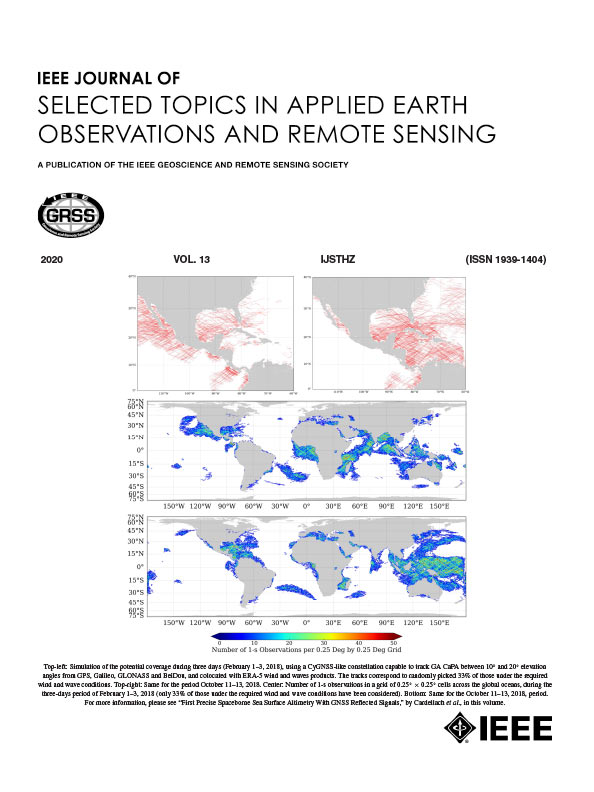A DCT-Based Local Contrast Enhancement Algorithm in SAR Image Target Detection
IF 5.3
2区 地球科学
Q1 ENGINEERING, ELECTRICAL & ELECTRONIC
IEEE Journal of Selected Topics in Applied Earth Observations and Remote Sensing
Pub Date : 2025-08-25
DOI:10.1109/JSTARS.2025.3602128
引用次数: 0
Abstract
Synthetic aperture radar (SAR) has become an indispensable remote sensing technology for maritime surveillance. Due to the influence of sea clutter, ship targets may be submerged in background noise, making it difficult for SAR ship target detection. In order to solve this problem, a discrete cosine transform (DCT)-based local contrast enhancement algorithm (DCT-LCE) is proposed in this article. By integrating DCT with sliding window, this algorithm innovatively transforms the SAR image into the DCT domain for processing. A weighted alternating current coefficients calculation method is designed to characterize statistical features within the sliding window, providing a quantitative method for distinguishing between targets and backgrounds. In addition, as optimization and improvement of DCT-LCE, multiscale DCT local contrast enhancement (MDCT-LCE) is proposed to enhance the detailed morphological information of ship targets. Experimental simulations demonstrate that the proposed algorithms can effectively enhance ship targets. Moreover, compared with other sliding window-based algorithms, the proposed algorithms have better detection performance both in accuracy and morphological features under different levels of complexity background.一种基于dct的SAR图像目标检测局部对比度增强算法
合成孔径雷达(SAR)已成为海上监视不可或缺的遥感技术。由于海杂波的影响,舰船目标可能被淹没在背景噪声中,给SAR舰船目标检测带来困难。为了解决这一问题,本文提出了一种基于离散余弦变换(DCT)的局部对比度增强算法(DCT- lce)。该算法创新性地将DCT与滑动窗口相结合,将SAR图像转换到DCT域进行处理。设计了一种加权交流系数计算方法来表征滑动窗口内的统计特征,为目标和背景的定量区分提供了一种方法。此外,作为DCT- lce的优化和改进,提出了多尺度DCT局部对比度增强(MDCT-LCE),增强舰船目标的详细形态信息。实验仿真结果表明,该算法能有效增强舰船目标。此外,与其他基于滑动窗口的算法相比,在不同复杂度背景下,所提算法在准确率和形态学特征方面都具有更好的检测性能。
本文章由计算机程序翻译,如有差异,请以英文原文为准。
求助全文
约1分钟内获得全文
求助全文
来源期刊
CiteScore
9.30
自引率
10.90%
发文量
563
审稿时长
4.7 months
期刊介绍:
The IEEE Journal of Selected Topics in Applied Earth Observations and Remote Sensing addresses the growing field of applications in Earth observations and remote sensing, and also provides a venue for the rapidly expanding special issues that are being sponsored by the IEEE Geosciences and Remote Sensing Society. The journal draws upon the experience of the highly successful “IEEE Transactions on Geoscience and Remote Sensing” and provide a complementary medium for the wide range of topics in applied earth observations. The ‘Applications’ areas encompasses the societal benefit areas of the Global Earth Observations Systems of Systems (GEOSS) program. Through deliberations over two years, ministers from 50 countries agreed to identify nine areas where Earth observation could positively impact the quality of life and health of their respective countries. Some of these are areas not traditionally addressed in the IEEE context. These include biodiversity, health and climate. Yet it is the skill sets of IEEE members, in areas such as observations, communications, computers, signal processing, standards and ocean engineering, that form the technical underpinnings of GEOSS. Thus, the Journal attracts a broad range of interests that serves both present members in new ways and expands the IEEE visibility into new areas.

 求助内容:
求助内容: 应助结果提醒方式:
应助结果提醒方式:


